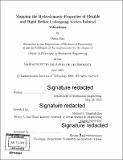| dc.contributor.advisor | Michael S. Triantafyllou. | en_US |
| dc.contributor.author | Fan, Dixia. | en_US |
| dc.contributor.other | Massachusetts Institute of Technology. Department of Mechanical Engineering. | en_US |
| dc.date.accessioned | 2019-09-16T21:15:48Z | |
| dc.date.available | 2019-09-16T21:15:48Z | |
| dc.date.copyright | 2019 | en_US |
| dc.date.issued | 2019 | en_US |
| dc.identifier.uri | https://hdl.handle.net/1721.1/122133 | |
| dc.description | Thesis: Ph. D., Massachusetts Institute of Technology, Department of Mechanical Engineering, 2019 | en_US |
| dc.description | Cataloged from PDF version of thesis. | en_US |
| dc.description | Includes bibliographical references (pages 233-243). | en_US |
| dc.description.abstract | Long slender structures within the steady oncoming flow are subject to vibrations caused by vortical structures forming due to a distributed flow instability in their wake. The features of these vibrations are a complex function of the main parameters, and hence systematic exploration of the basic mechanisms has only recently begun. The problem has considerable theoretical interest as it constitutes a fundamental nonlinear flow-structure interaction system, while it is very important for the design of offshore industry systems, such as risers, cables, and hawsers, which are subject to large drag loads and potentially catastrophic fatigue damage as a consequence of the vortex-induced vibrations. The much simpler problem of a flexibly mounted rigid cylinder in cross-flow has become the canonical problem of bluff body flow-structure interaction and has been extensively studied and mapped both experimentally and computationally. | en_US |
| dc.description.abstract | Attempts have been made to extend and apply the properties and databases found in rigid structures to flexible structures. This requires, first of all, a strip-theory approach, but it was also found that additional concepts are needed, such as the presence of "hybrid" modes consisting of mixed traveling and standing waves, a strong interaction between in-line and cross-flow modal responses, and a response that consists of multiple frequencies. In this thesis we employ an optical tracking experimental tool that can measure the detailed vibrational response and also allows the evaluation of the distributed forces acting along the structure, together with targeted CFD calculations that provide the detailed vortical structures in the wake, to investigate some fundamental properties of the vortex-induced vibrations of flexible structures, and assess the validity of basic assumptions that are currently in use. | en_US |
| dc.description.abstract | Specifically, we assess first the validity of the strip theory approach that uses databases obtained from rigid cylinders to calculate the local forces in a flexible structure. We compare the experimentally derived forces in a flexible structure with those obtained from the rigid cylinder and we find the conditions under which they are applicable. Next, we demonstrate that a newly designed "Intelligent Towing Tank" (ITT) can derive with a minimal number of experiments databases for rigid cylinders to be used for flexible structure response prediction, covering the entire parametric space. We employ Gaussian Process Regression to guide the selection of a sequence of experiments in an automated Towing Tank to cover the parametric space within narrow uncertainty range. Our findings are as follows: 1. | en_US |
| dc.description.abstract | The strip theory assumption for uniform flexible structures in uniform flow undergoing in-line and cross-flow oscillations is applicable, but additional concepts are needed to describe the form of the extended coupling of flow and structure, which we discuss in detail. 2. For a flexible cylinder consisting of two segments of equal length but different diameter, it is shown that the strip theory approach is still valid, but the existing rigid cylinder databases do not provide accurate force estimates because they fail to account for multi-frequency response. 3. We derived a new database for rigid cylinders that accounts for a two-frequency response. This was made possible due to the substantial experimental time saving of the ITT. A major conclusion is that when the response contains two frequencies that are both within the excitation region, reduced energy is transferred from the fluid to structure. | en_US |
| dc.description.statementofresponsibility | by Dixia Fan. | en_US |
| dc.format.extent | 354 pages | en_US |
| dc.language.iso | eng | en_US |
| dc.publisher | Massachusetts Institute of Technology | en_US |
| dc.rights | MIT theses are protected by copyright. They may be viewed, downloaded, or printed from this source but further reproduction or distribution in any format is prohibited without written permission. | en_US |
| dc.rights.uri | http://dspace.mit.edu/handle/1721.1/7582 | en_US |
| dc.subject | Mechanical Engineering. | en_US |
| dc.title | Mapping the hydrodynamic properties of flexible and rigid bodies undergoing vortex-induced vibrations | en_US |
| dc.type | Thesis | en_US |
| dc.description.degree | Ph. D. | en_US |
| dc.contributor.department | Massachusetts Institute of Technology. Department of Mechanical Engineering | en_US |
| dc.identifier.oclc | 1117710236 | en_US |
| dc.description.collection | Ph.D. Massachusetts Institute of Technology, Department of Mechanical Engineering | en_US |
| dspace.imported | 2019-09-16T21:15:45Z | en_US |
| mit.thesis.degree | Doctoral | en_US |
| mit.thesis.department | MechE | en_US |
